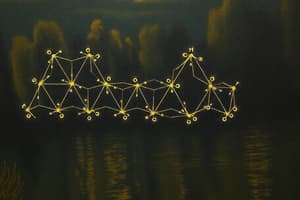Podcast
Questions and Answers
Why do ionic compounds typically exhibit high melting and boiling points?
Why do ionic compounds typically exhibit high melting and boiling points?
- The strong electrostatic forces between ions require a large amount of energy to overcome. (correct)
- The weak electrostatic forces between ions require little energy to overcome.
- The mobile electrons within the lattice structure facilitate easy separation of ions.
- The strong covalent bonds within the crystal lattice demand substantial energy to break.
What happens to the electrical conductivity of an ionic compound when it is dissolved in water, and why?
What happens to the electrical conductivity of an ionic compound when it is dissolved in water, and why?
- It increases because the ions become free to move and carry charge. (correct)
- It disappears completely as the compound dissociates into neutral atoms.
- It remains the same because the number of charge carriers does not change.
- It decreases because the water molecules interfere with electron flow.
In the formation of potassium chloride (KCl), what describes the electron transfer between potassium (K) and chlorine (Cl)?
In the formation of potassium chloride (KCl), what describes the electron transfer between potassium (K) and chlorine (Cl)?
- Potassium and chlorine both gain one electron, forming K⁻ and Cl⁻ respectively.
- Potassium gains one electron to form K⁺, and chlorine loses one electron to form Cl⁻.
- Potassium shares one electron with chlorine, forming a covalent bond.
- Potassium loses one electron to form K⁺, and chlorine gains one electron to form Cl⁻. (correct)
What is the correct Lewis dot structure representation for magnesium oxide (MgO)?
What is the correct Lewis dot structure representation for magnesium oxide (MgO)?
In drawing Lewis dot diagrams for covalent compounds, what is the significance of 'pairing electrons'?
In drawing Lewis dot diagrams for covalent compounds, what is the significance of 'pairing electrons'?
What is the most important factor to consider when balancing charges in ionic compounds?
What is the most important factor to consider when balancing charges in ionic compounds?
What is the correct name for $Fe_2O_3$, considering that iron (Fe) is a multivalent metal?
What is the correct name for $Fe_2O_3$, considering that iron (Fe) is a multivalent metal?
What is the purpose of using brackets when writing the formula for an ionic compound containing polyatomic ions, such as calcium nitrate, $Ca(NO_3)_2$?
What is the purpose of using brackets when writing the formula for an ionic compound containing polyatomic ions, such as calcium nitrate, $Ca(NO_3)_2$?
What is the correct name for $N_2O_5$, considering the rules for naming molecular compounds?
What is the correct name for $N_2O_5$, considering the rules for naming molecular compounds?
In naming molecular compounds, when is the prefix 'mono-' omitted from the name?
In naming molecular compounds, when is the prefix 'mono-' omitted from the name?
Flashcards
Ionic compounds
Ionic compounds
Formed when a metal transfers electrons to a non-metal, creating positive and negative ions that attract each other.
High melting/boiling points
High melting/boiling points
High energy needed to overcome strong ionic bonds.
Hard and brittle
Hard and brittle
Rigid crystal lattice breaks due to like charge repulsion when disturbed.
Conductivity when dissolved/molten
Conductivity when dissolved/molten
Signup and view all the flashcards
Cations
Cations
Signup and view all the flashcards
Anions
Anions
Signup and view all the flashcards
Covalent bonds
Covalent bonds
Signup and view all the flashcards
Naming Binary Ionic Compounds
Naming Binary Ionic Compounds
Signup and view all the flashcards
Naming Multivalent Ionic Compounds
Naming Multivalent Ionic Compounds
Signup and view all the flashcards
Naming Molecular Compounds
Naming Molecular Compounds
Signup and view all the flashcards
Study Notes
- Ionic compounds arise from electron transfer between a metal and a non-metal, resulting in positive and negative ions.
Properties of Ionic Compounds
- High melting and boiling points are due to strong ionic bonds requiring significant energy to break.
- Hardness and brittleness result from a rigid crystal lattice structure that shatters upon disturbance due to like charges repelling.
- Conductivity occurs when dissolved or molten because ions are free to move and carry electric charge.
- Solubility in water is common, leading to the formation of ions in solution.
Drawing Ionic Bonding (Lewis Dot Diagrams)
- Ionic bonds occur between metals and non-metals.
- Metals lose electrons to become positively charged cations, while non-metals gain electrons to become negatively charged anions.
- Step 1: Write the symbols of the metal and non-metal side by side
- Step 2: Represent valence electrons as dots around each symbol.
- Step 3: Transfer electrons from the metal to the non-metal.
- Step 4: Draw the resulting ions with charges, enclosing them in square brackets, for example, [Na]⁺ [Cl]⁻.
- In sodium chloride (NaCl), Na has 1 valence electron and Cl has 7.
- Na loses 1 electron to become Na⁺, and Cl gains 1 electron to become Cl⁻.
- The final representation is [Na]⁺ [Cl]⁻.
Drawing Molecular Bonding (Lewis Dot Diagrams)
- Covalent bonds form between non-metals, involving the sharing of electrons to achieve full outer shells.
- Step 1: Write the symbols of the non-metal atoms side by side.
- Step 2: Show valence electrons as dots around each atom.
- Step 3: Pair electrons to form bonds, with each shared pair representing a covalent bond (represented by a line).
- Step 4: Check that each atom has a full outer shell, typically 8 electrons (or 2 for hydrogen).
- In water (H₂O), O has 6 valence electrons, and each H has 1.
- O shares 1 electron with each H, forming two single bonds.
- The oxygen atom in water has 2 lone pairs and 2 shared pairs with hydrogen atoms.
Writing Chemical Formulas and Names
- Follow specific rules based on the type of compound.
Binary Ionic Compounds (Metal + Non-metal)
- Formula: Write the metal symbol first, followed by the non-metal, ensuring that the charges are balanced
- Name: Use the metal name followed by the non-metal name with an "-ide" ending.
- NaCl is named Sodium chloride.
Multivalent Ionic Compounds (Transition Metals)
- Formula: Write the symbols for the metal and non-metal, balancing the charges.
- Name: Indicate the metal's charge using Roman numerals in parentheses.
- FeCl₃ is named Iron (III) chloride because it contains Fe³⁺ and 3 Cl⁻ ions.
Polyatomic Ionic Compounds (Ions with Multiple Atoms)
- Formula: Write the symbols for the metal and polyatomic ion, balancing the charges, use brackets if there is more than one polyatomic ion.
- Name: Use the name of the metal followed by the name of the polyatomic ion.
- Ca(NO₃)₂ is named Calcium nitrate.
Molecular Compounds (Non-metal + Non-metal)
- Formula: Use prefixes to denote the number of atoms of each element.
- Name: Combine prefixes with the element names, adding "-ide" to the second element (omit "mono-" for the first element).
- Prefixes indicate the number of atoms: 1-Mono, 2-Di, 3-Tri, 4-Tetra, 5-Penta, 6-Hexa, 7-Hepta, 8-Octa, 9-Nona, 10-Deca.
- CO₂ is named Carbon dioxide.
Studying That Suits You
Use AI to generate personalized quizzes and flashcards to suit your learning preferences.




